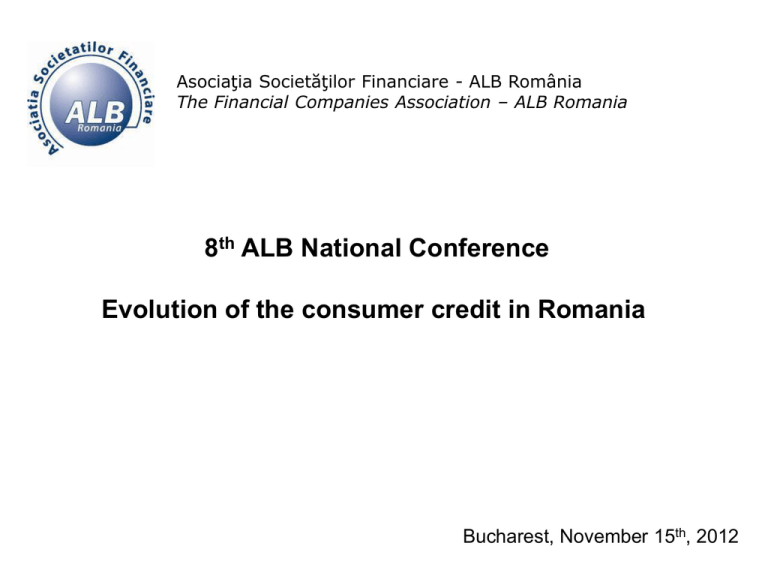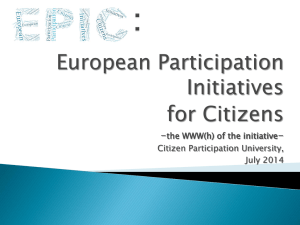presentation
advertisement

Asociaţia Societăţilor Financiare - ALB România The Financial Companies Association – ALB Romania 8th ALB National Conference Evolution of the consumer credit in Romania Bucharest, November 15th, 2012 1 The European market accounts for 24% of the global market Consumer Credit Outstanding per Region at the end of 2011 Sources: central banks, Asteres estimates The global outstanding reached 5,597 billion € at the end of 2011, +4.5% compared with the end 2010 o 39% of the global outstanding is in North America: United States (32%), Canada (6%), Mexico (>1%) o Asia and the Middle East represents the second group with 29% of the global outstanding o Europe incl. Turkey and Russia is the third one with 1314 billion €, or 24% of the global outstanding 2 Contrasting dynamics by regions Evolution 2011/2010 of Consumer Credit Outstanding per Region (%) Sources: Asteres estimates The overall increase of the global market (+4.5%) demonstrates a certain amount of momentum However, this increase conceals a decoupling between emerging markets, with brisk growth, and developed markets (except North America) which are struggling or even in decline o South America achieved the highest growth o Asia and the Middle East (including Japan) posted a growth of 5%, but slowed down by Japan, the first market of the region. Excluding Japan, the growth of this region was 16% o The markets in North America and in Europe have reached maturity and present more moderate growth The market picked up in North America (+3.9% in 2011 following a fall of -1.7% in 2010) In Europe (+1.3%) the market was driven by emerging economies, outside EU, with growth of +41% in Russia and +34% in Turkey while the EU27 saw a fall of -2.9% 3 EU27 : the consumer credit outstanding unequally distributed Consumer Credit Outstanding at the end of 2011 (EU27) Romania : Outstanding 14,6 billion€ = 1,4% of EU27 Sources: central banks, Asteres estimates The markets are unequally distributed: the top 5 markets account for 75% of the total, while representing 63% of the population The European market can be split into 3 main groups : o Northern Europe: 56% of the outstanding (41% of population ) o Southern Europe: 37% of the outstanding (39% of population) o Eastern Europe : 7% of the outstanding (20% of population) 4 EU27: for the 2nd consecutive year the consumer credit outstanding dropped by 2.9% in 2011 This was due to the degradation of the European financial and economic environment: o Low consumption in most of the countries (weak GDP growth, austerity measures in some countries) o High unemployment rate ( limiting access to the credit) Only 7 out of 27countries posted a growth of the outstanding in 2011 Excluding Slovakia, all Central & Eastern countries fell Romania was also adversely affected in 2011 : - 3.5% Sources: central banks, Asteres estimates5 A clear link between the consumer credit growth and the GDP growth Growth of the consumer credit outstanding versus of the GDP growth (2011/2010) 3 countries showing a decrease in outstanding: Romania (-3.5% yoy), Poland (-2.7% yoy) and Bulgaria (-2,2%yoy) Some of the emerging countries have their credit consumer markets growing fast : Argentina (+50% yoy), Brazil(+20% yoy), Turkey (+32% yoy) and Russia (41% yoy) 6 Credit to individuals (consumer and mortgage) compared to GDP Total credit outstanding to individuals ( consumer and mortgage) related to GDP in 2011 The total households indebtedness (consumer and mortgage) compared to GDP is low in Romania (17%) Romania is among the countries with the lowest share of mortgage credit in total credit (35%). However it increased compared to 2010 , when it was 31% 7 Romania : high consumer credit penetration in % of GDP Consumer credit outstanding divided by GDP (2011) Consumer credit penetration is important in Romania : 10.7% of GDP at the end of 2011 o However, it is decreasing from the 12.6% of GDP at the end of 2010 Average outstanding per inhabitant in Romania in 2011: 671€ (also decreasing from 704 € in 2010) 8 A Romanian market particularly hit by the crisis in 2009, recovering progressively Consumer Credit Outstanding (banks + IFN) - June 2012: 65.2 bn. RON, decreasing for the fourth consecutive year: 2009/2008 0.00% -2.00% -2.00% 2010/2009 2011/2010 2012/2011 (June yoy) -3.50% -3.60% -4.00% -6.00% -11.50% A small market at the European -8.00% -10.00% level: 1.4% of the outstanding -12.00% but important in the Central & -14.00% Eastern region (#2 after Poland) One of the most shaken markets: A very fast growth before the crisis: +82% and +34% in outstanding 2007/2006 and 2008/20067) Then a significant drop in 2009: -60% in production Slow recovery in 2010 (+10%) and in 2011 (+10%) in 2011 We expect the consumer credit production to recover the 2008 level only in 2013 or 2014 9 IFN results: New credit granted by Product Type S1-2012 2.1% 6.5% Consumer credit for personal consumption / Credite destinate consumului personal Credits for Vehicles / Credite auto EUR 225.87 million Industrial Credit/ Credite Industriale 91.4% Source: ASOCIATIA SOCIETATILOR FINANCIARE – ALB ROMANIA 10 IFN results: New credit granted for Personal Consumption S1-2012 Gradual recovery in terms of new credit granted for personal consumption in S1-2012: +3.7% vs. S1-2011 : o Revolving loans including credit cards: +18% S1-2012/S1-2011 o Direct personal loans: +4% S1-2012/S1-2011 o Credit at POS: -19% S1-2012/S1-2011 Credit at Point of Sale EUR 206.51 million Direct Personal Loans Revolving credit including credit cards Source: ASOCIATIA SOCIETATILOR FINANCIARE – ALB ROMANIA 11 Credit Risk Evolution Globally, the cost of risk (coming from new provisions) of the Consumer Credit companies increased strongly in 2009, and decreased in 2010 and 2011, thanks to a renewed approach both on lenders and consumers sides. Banking sector : o The rate of non-performing loans has increased from 11.9% of total loans in Dec. 2010 to 14.3% in Dec. 2011 finally reaching 16.8% in June 2012 (aggregate level: corporate + individuals loans) o But this is a stock: it increases because the nonperforming loans remain a long time in the books. Only the flux (new non performing loans) trigger new provisions. Sources: National Bank of Romania The weight of the foreign currency loans is very important, representing a threat for the households’ financial health (% of foreign currency loans among total consumer credit outstanding): o 30% in Dec. 2006 48 % in Dec. 2008 56 % in Dec. 2010 57% in Jun. 2012 12 Conclusion After the difficult 2009-2010 period, the Romanian consumer credit market is progressively recovering : o In terms of volumes – but this will need time o In terms of credit risk : we believe the non performing loans will reach the peak in 2012, followed by a better trend starting with 2013 The regulatory environment is changing fast o Globally in a good direction: favoring transparency (ex : OUG 50 ) and responsibility of consumers and lenders (new NBR Regulation - foreign currency loans) o New regulations expected, especially from the EU (i.e. Shadow banking) The approach of the lenders has been reviewed during the crisis. o Processes (incl. granting rules) o Transparency (ex : costs) ALB Code of Conduct in place 13








